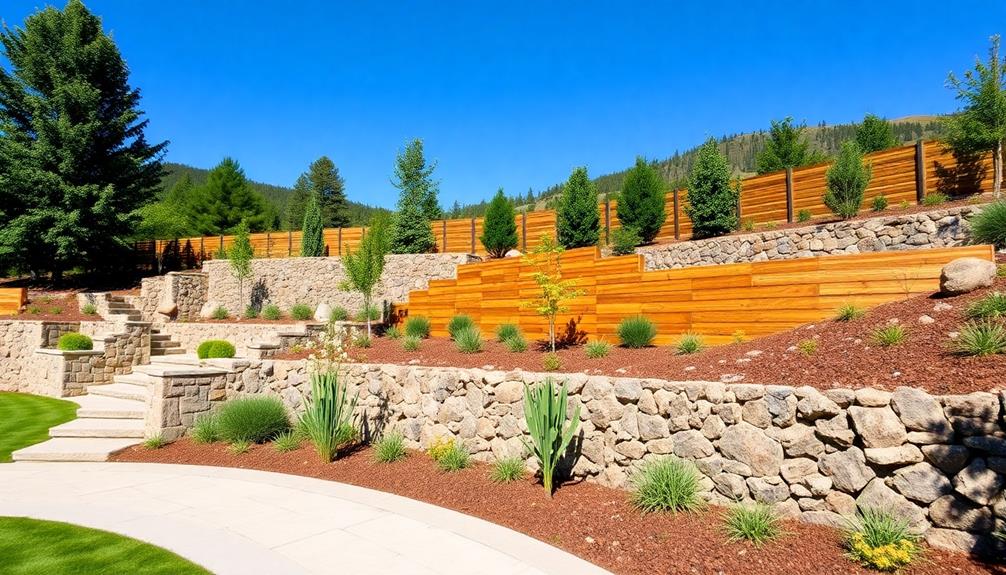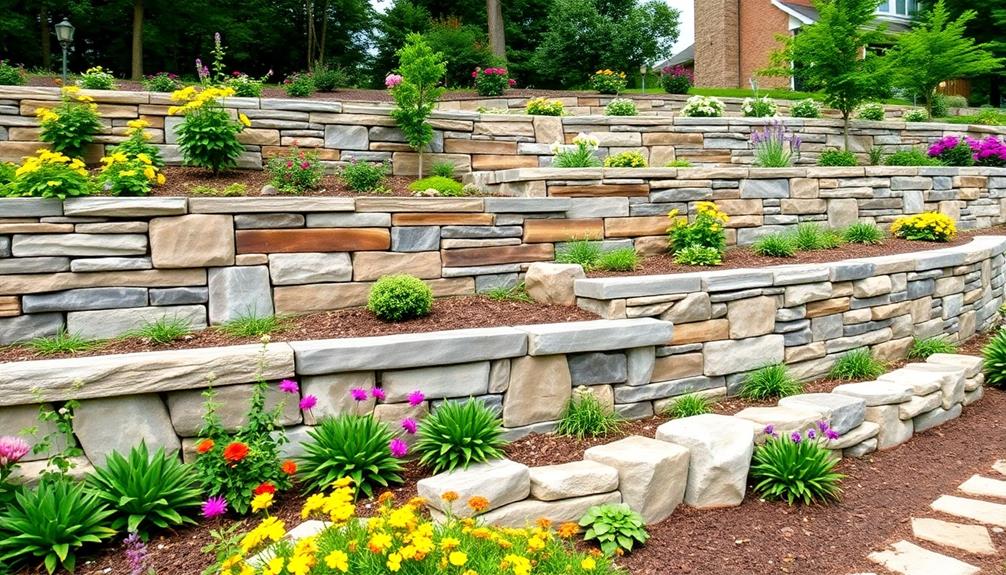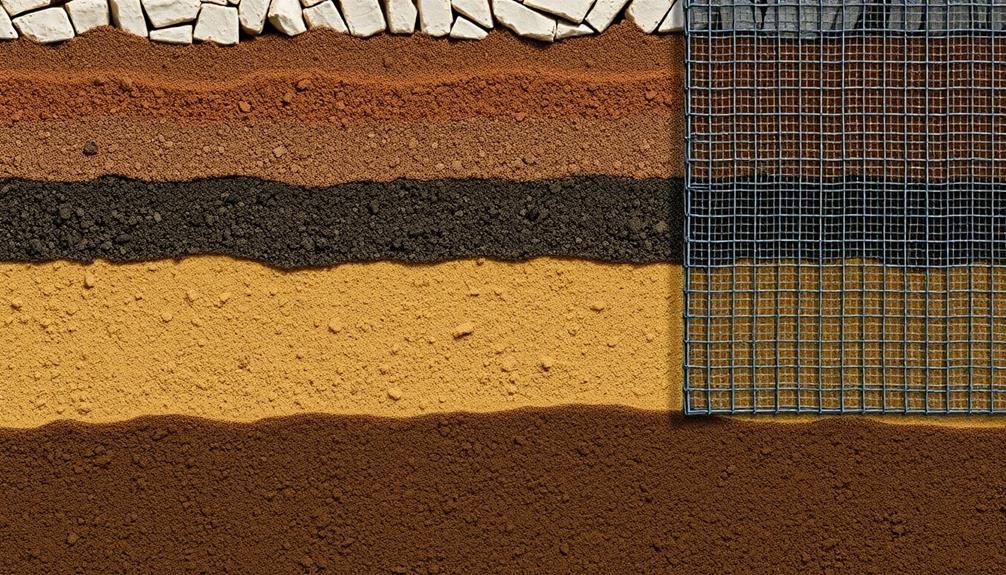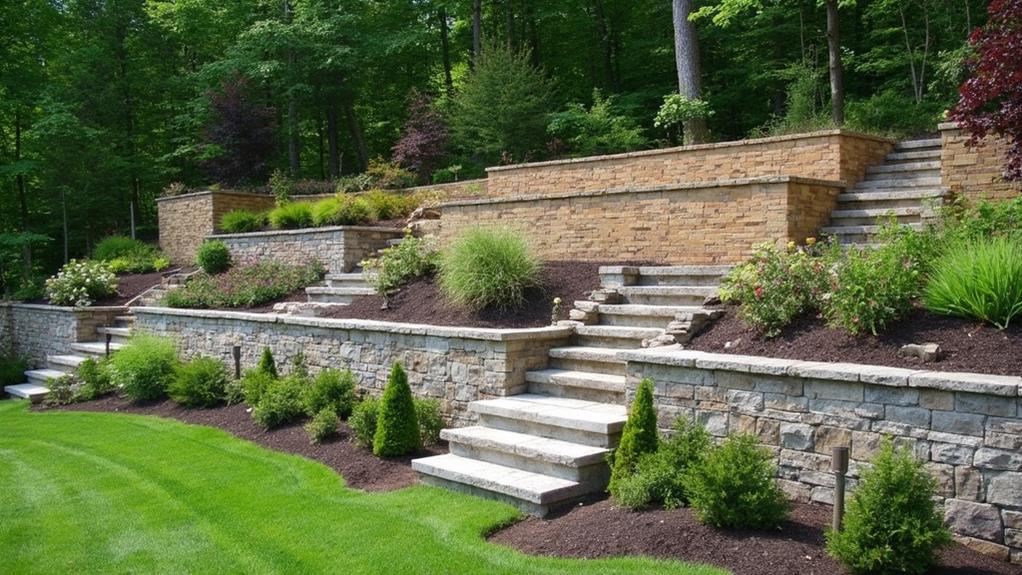Retaining wall materials encompass a diverse range of options, each uniquely catering to aesthetic, structural, and environmental needs in various applications. Gravity walls are constructed using heavy materials like stone, concrete, or brick, leveraging mass to maintain stability. Reinforced earth structures blend natural and man-made materials, offering eco-friendly flexibility for difficult terrains. Anchored wall techniques employ cables or rods to enhance support in high-load and confined urban spaces. Common materials include concrete, prized for its strength and versatility; stone, valued for its durability; and wood, appreciated for its rustic charm, each with qualities suited to a myriad of design intentions. Further exploration discloses specific benefits and environmental considerations inherent to these materials.
Table of Contents
ToggleWalls Contractor Highlights
- Concrete offers versatility, durability, and a range of design options for contemporary aesthetics and structural stability.
- Natural stone provides a timeless, aesthetic appeal combined with exceptional strength and weather resistance.
- Brick offers solid load-bearing capabilities and various aesthetic possibilities, blending tradition with practicality.
- Wood delivers a rustic charm and cohesive integration with natural landscapes, suitable for eco-friendly designs.
- Reinforced earth systems utilize materials like geogrid or geocells for enhanced stability and adaptability to terrain shifts.
Types of Retaining Walls

The selection of retaining wall types encompasses a variety of designs that cater to different structural requirements and site conditions. Gravity walls rely on their substantial weight to withstand lateral earth pressures, and they are often seen as a cost-effective solution due to their simplicity and robustness.
The long-lasting nature of certain materials like boulders also enhances their appeal, making them a popular choice for decorative and functional purposes. Reinforced earth structures integrate materials such as steel strips or geotextiles to enhance the wall's load-bearing capacity. Anchored wall techniques employ cables or rods driven into the soil to provide additional support, making them suitable for high-load scenarios and complex engineering challenges.
Gravity Walls Design
As a fundamental type of structure in retaining wall design, gravity walls rely primarily on their own weight to withstand lateral earth pressures. These walls, commonly constructed from stone, concrete, or brick, are self-supporting through mass and friction between the materials and the subbase, which prevents sliding or toppling. The sheer mass of these walls allows them to counteract the forces exerted by the earth behind them, making them suitable for various terrains and conditions.
The design of gravity walls depends considerably on their purpose and the landscape's specific requirements. Typically, gravity walls are up to three meters high, but increasingly tailored designs are emerging to accommodate higher elevations by incorporating varied shapes and thicknesses that further compound their loading capacity. Among the options available, the choice of material significantly affects the design's longevity and integration into the surroundings, balancing aesthetics with functionality.
For those invested in stable and enduring structures, gravity walls offer a steadfast solution. They stand as an enduring representation of both ancient building traditions and modern engineering principles, seamlessly combining the simplicity of their design with the complexity required to support shifting terrains. Through meticulous planning and execution, gravity walls affirm their place in safeguard and beautify spaces.
Reinforced Earth Structures
Reinforced earth structures stand as a versatile and robust category within retaining wall systems, incorporating both natural and man-made materials to enhance stability. These systems rely on the fundamental interplay between compacted granular soil and tensile reinforcements such as geogrids, geotextiles, or steel strips to form a monolithic mass capable of withstanding substantial lateral earth pressures. The reinforcements are embedded systematically within the soil, creating an integrated composite that efficiently disperses stress throughout the structure.
Within the community of engineers and builders invested in sustainable and resilient infrastructure, reinforced earth structures offer not only enhanced structural integrity but also aesthetic flexibility. A wide array of facing options, including precast concrete panels and natural stone, allows these retaining walls to complement diverse architectural styles, reinforcing a sense of coherence in both urban and rural landscapes. The adaptability of reinforced earth systems is further highlighted in their application across varied terrains, including steep slopes and demanding topographies, where conventional retaining walls might falter.
Incorporating eco-friendly practices, such as using locally sourced materials and minimizing excavation, aligns reinforced earth structures with modern environmental goals, fostering a sense of belonging to a community dedicated to enduring and conscientious development.
Anchored Wall Techniques
While reinforced earth structures offer versatility and resilience, anchored wall techniques present an innovative approach for addressing complex retaining challenges. These techniques become indispensable in scenarios demanding heightened stability and intricate design, enhancing the potential of retaining structures in varied landscapes. By understanding the intricacies of anchored walls, we can immerse ourselves into how this method augments the engineering toolkit in slope stabilization.
Anchored walls incorporate cables known as tendons, which are securely fastened to the soil or rock behind the wall. These walls find applications in situations necessitating additional support that gravity and friction alone cannot provide.
- Design Flexibility: Anchored walls are adaptable to diverse site conditions, making them suitable for urban environments with restricted space.
- Enhanced Load Capacity: The use of tendons allows these walls to withstand significant pressure, ensuring stability under heavy loads.
- Minimal Footprint: Compared to other types, anchored walls require less material and space, optimizing land usage.
- Long-term Durability: Anchoring enhances the longevity of the wall, reducing maintenance needs and ensuring prolonged structural integrity.
Benefits

Retaining wall materials provide a multitude of benefits, including enhanced structural stability that guarantees safety and reliability for varied landscapes. Companies like the Granite Company, established over 20 years ago, specialize in creating high-quality retaining walls that withstand various weather conditions.
These materials come with diverse aesthetic options, allowing for customization to suit any environmental or design requirements, while also prioritizing longevity and durability, which reduce the need for frequent maintenance. Consequently, many modern retaining wall solutions incorporate eco-friendly options, promoting sustainability by utilizing materials that minimize environmental impact.
Enhanced Structural Stability
How does the choice of retaining wall material impact its structural stability? The selection is pivotal, as each material offers distinct stability attributes contributing to the wall's performance against soil pressure and environmental factors. Various materials provide varying degrees of strength, durability, and longevity that are essential for the structural integrity of retaining walls, ultimately reinforcing their ability to stabilize slopes and manage earth movements effectively.
Certain materials, like concrete and natural stone, are known for their exceptional load-bearing capabilities, solidifying the wall's ability to withstand immense pressure over time without compromising its structure.
Materials like brick and interlocking blocks are particularly useful in environments susceptible to erosion, providing a solid barrier against natural wear and tear.
Reinforced earth systems and modular block systems can easily adapt to ground shifts, offering a balance between rigidity and flexibility essential for long-term stability.
Wood, while aesthetically pleasing, may lack the weather resistance found in engineered materials like steel or reinforced concrete, which can better endure harsh climatic conditions without degradation.
Informed choices regarding retaining wall materials not only reinforce enhanced stability but also foster a sense of belonging as the structure reliably integrates into the environment it supports.
Aesthetic Appearance Options
When considering the aesthetic options for retaining walls, what artistic possibilities do different materials offer? The choice of material greatly influences the visual appeal and character of a landscape.
Brick and stone retain the allure of craftsmanship, providing a classic, timeless aesthetic that resonates with traditional values, while the natural textures and colors of these materials blend seamlessly with the surrounding environment, creating a cohesive, integrated landscape. Wood imparts a warm, rustic charm that appeals to those seeking natural purity and simplicity, offering an inviting touch for gardens and home landscapes.
Concrete, with its versatile form and finish options, enables a contemporary aesthetic. This material allows for customization through color additives, surface textures, and finishes, like stamped or stained concrete, which cater to personal preferences for modern designs. Gabion walls, which incorporate rock-filled wire cages, introduce a rugged industrial look, appealing to those who favor eclectic, innovative styles.
For those with sustainability in mind, recycled materials present not just eco-friendly solutions but contribute to unique, creative designs. These diverse options open pathways for personal expression, enabling individuals to curate landscapes that reflect their own stories and values, fostering a sense of belonging within their spaces.
Longevity and Durability
Why do some retaining walls stand the test of time while others falter? The answer often lies in the choice of materials, each with distinctive qualities that influence their longevity and durability. Retaining walls are integral to landscaping, serving not only functional purposes but also as structures that foster a sense of permanence within our community settings.
Concrete is known for its exceptional strength and is a popular choice, offering robustness against weather variations, resisting erosion, and lasting decades with minimal maintenance.
Natural stone, while often on the pricier side, provides unmatched aesthetic appeal alongside superior durability, gracefully withstanding the elements while adding timeless beauty to the landscape.
Although more susceptible to decay, especially in damp conditions, specially treated timber offers a rustic charm and, with proper care, can serve effectively over the years.
Providing both durability and natural appeal, boulder walls lend an organic feel to landscaped areas and, given their mass, they excel at providing long-term structural stability.
Assessing the environmental conditions, maintenance willingness, and desired lifespan is indispensable in choosing the ideal retaining wall material, ensuring these structures not only fulfill their purpose but also become enduring elements of the landscape.
Eco-Friendly Solutions
Sustainability is at the forefront of modern construction practices, and retaining walls are no exception. Eco-friendly solutions offer numerous benefits that align with the ethical and practical needs of today's environmentally-conscious community. These methods involve the use of sustainable materials and innovative techniques designed to guarantee reduce environmental impact while enhancing structural integrity. Utilizing recycled materials such as reclaimed wood, crushed concrete, and eco-blocks not only minimizes waste but also preserves natural resources, embodying a deep respect for the planet.
Moreover, the incorporation of green retaining walls, which integrate living plants, enhances biodiversity and contributes to the local ecosystem by providing habitats for various organisms. Such solutions also improve air quality and reduce the urban heat island effect, illustrating a commitment to holistic environmental stewardship. Additionally, the use of indigenous plants ensures minimal disruption to local flora and fauna, furthering the sense of belonging to the natural surroundings.
Ultimately, eco-friendly retaining walls offer a multitude of advantages by seamlessly blending functional engineering with ecological conservation. They provide aesthetically pleasing, economically viable, and socially responsible options that resonate with a shared desire to contribute positively to the environment and the future of sustainable living.
Soil Reinforcement Techniques

In exploring soil reinforcement techniques for retaining walls, the implementation of geogrid reinforcement stands out as it enhances soil stability through its tensile strength and adaptability to various soil types. The soil nailing method offers another robust solution, employing steel bars to stabilize slopes, especially in areas where space limitations restrict large excavation. Additionally, geocells provide an innovative approach by utilizing three-dimensional honeycomb structures to confine and stabilize infill materials, effectively distributing loads and limiting erosion.
| Technique | Key Benefits | Applications |
|---|---|---|
| Geogrid Reinforcement | Enhances stability and flexibility | Roads, retaining walls |
| Soil Nailing | Provides strong slope stabilization | Steep slopes, restricted spaces |
| Geocells | Distributes loads, limits erosion | Embankments, erosion control |
Geogrid Reinforcement Benefits
Geogrid reinforcement offers a robust solution for enhancing the structural integrity of retaining walls through soil reinforcement techniques. These grid-like structures are integral to ensuring long-lasting stability by interlocking with soil, creating a composite mass that can withstand significant lateral pressures. The versatility of geogrids allows for their application across diverse projects, incorporating the foundational science of soil mechanics in their design.
The benefits of geogrid reinforcement include:
- Increased Load-Bearing Capacity: Geogrids distribute loads effectively, reducing stress concentrations and enhancing the wall's overall load-carrying capacity, thus ensuring durability over time.
- Cost Efficiency: By improving the mechanical properties of soil, geogrids reduce the need for extensive excavation and wall thickness, leading to significant cost savings during construction.
- Environmental Consideration: This method supports sustainable practices by minimizing landscape disruption and maximizing the use of local soil materials, fostering a harmonious integration with natural surroundings.
- Ease of Installation: The flexibility and adaptability of geogrids simplify installation processes, allowing for rapid deployment, which is particularly beneficial in time-sensitive projects.
Adopting geogrid reinforcements aligns with a commitment to quality and longevity, offering a sophisticated yet practical solution while fostering a sense of reliability and community within engineering and construction sectors.
Soil Nailing Method
The Soil Nailing Method represents a pivotal technique in soil reinforcement, particularly for stabilizing steep slopes and retaining walls. This innovative method involves the insertion of slender, steel-threaded rods into a pre-drilled hole in the soil, which are then grouted to create a composite mass that offers increased stability.
Widely regarded for its adaptability, soil nailing is suitable for a variety of geological conditions, from loose soils to soft rock, ensuring that natural landscapes can be preserved while enhancing their structural integrity.
A remarkable aspect of soil nailing is its ability to retrofit existing structures while minimizing site disturbance. Its utilization is particularly advantageous in urban environments where space is constrained and traditional construction methods might disrupt nearby areas. By reinforcing slopes from inside out, this method allows for greater flexibility and continuity of design in developing infrastructure, while maintaining environmental harmony.
The procedure is further characterized by its rapid installation and cost-effectiveness. As it largely uses readily available materials and equipment, its implementation aligns with sustainable construction practices. For communities prioritizing safety and sustainable development, the soil nailing method offers both reassurance and efficiency, creating durable foundations for the future.
Use of Geocells
Beyond soil nailing, another exemplary soil reinforcement technique is the use of geocells, which provide a robust solution for retaining wall construction and slope stabilization. Geocells are three-dimensional, honeycomb-like structures made from polymeric strips, capable of confining soil particles within their pockets, greatly enhancing the shear strength of the terrain. This method is particularly valued for its adaptability and effectiveness across various geotechnical applications, fundamentally transforming soil materials into a cohesive cellular structure capable of resisting erosive forces and load pressures.
The advantages of utilizing geocells include:
- Versatility: Geocells are highly flexible and can be tailored to suit various terrain contours and environmental conditions, allowing for efficient adaptation to project-specific requirements.
- Environmental Friendliness: These structures enable the reduction of construction footprint and soil disturbance, with the added benefit of accommodating vegetation growth, thereby promoting ecological stabilization.
- Cost-Effectiveness: The installation of geocells is relatively straightforward, reducing labor and equipment costs while minimizing construction time, making them an economically attractive option.
- Durability: Constructed from high-density materials, geocells resist degradation from biological, chemical, and environmental factors, ensuring long-term stability and function.
Walls Contractor FAQ
How Do I Determine the Most Cost-Effective Retaining Wall Material for My Project?
Evaluating cost-effectiveness involves examining material durability, local availability, and installation labor. Consider long-term maintenance and environmental impact. Consulting with construction professionals verifies informed decisions, fostering a sense of community through sustainable and economically sound project execution.
What Are the Common Maintenance Requirements for Various Retaining Wall Materials?
Routine maintenance for retaining wall materials includes periodic inspection for structural integrity, ensuring proper drainage to prevent water buildup, cleaning to remove debris, and addressing any visible signs of wear. Regular assessments foster longevity and community safety.
How Do Weather Conditions Affect the Longevity of Different Retaining Wall Materials?
Weather conditions, such as moisture levels, temperature fluctuations, and freeze-thaw cycles, substantially impact retaining wall longevity. Proper material selection, including weather-resistant options, and regular maintenance enhance durability, ensuring structural integrity and fostering a sense of community safety and reliability.
Can I Install a Retaining Wall Myself, or Should I Hire a Professional?
While attempting a DIY retaining wall installation can be enticing, hiring a professional guarantees adherence to safety standards, ideal structural integrity, and longevity. Professionals possess the expertise to factor in considerations like soil, drainage, and design for long-term success.
What Are the Environmental Impacts of Different Retaining Wall Materials?
Understanding the environmental impacts of retaining wall materials assists communities in choosing sustainable options. Different materials vary in life cycle emissions, resource use, and biodiversity effects, impacting ecosystems and aligning with collective ecological goals for shared spaces.







